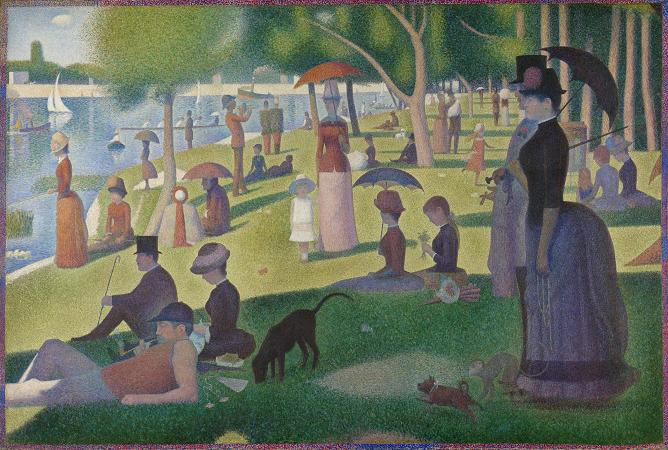
Sunday Afternoon on Grande Jatte. A Sunday Afternoon on the Island of La Grande Jatte painted in 1884, is Georges Seurat's most famous work.
It is a leading example of pointillist technique, executed on a large canvas. Seurat's composition includes a number of Parisians at a park on the banks of the River Seine.
In 1879 Georges Seurat enlisted as a soldier in the French army and was back home by 1880. Later, he ran a small painter's studio in Paris, and in 1883 showed his work publicly for the first time.
The following year, Seurat began to work on La Grande Jatte and exhibited the painting in the spring of 1886 with the Impressionists. With La Grande Jatte, Seurat was immediately acknowledged as the leader of a new and rebellious form of Impressionism called Neo-Impressionism.
Seurat painted A Sunday Afternoon between May 1884 and March 1885, and from October 1885 to May 1886, focusing meticulously on the landscape of the park. He reworked the original and completed numerous preliminary drawings and oil sketches. He sat in the park, creating numerous sketches of the various figures in order to perfect their form. He concentrated on issues of colour, light, and form. The painting is approximately 2 by 3 meters in size. Inspired by optical effects and perception inherent in the color theories of Michel Eugene Chevreul, Ogden Rood and others, Seurat adapted this scientific research to his painting. Seurat contras
It is a leading example of pointillist technique, executed on a large canvas. Seurat's composition includes a number of Parisians at a park on the banks of the River Seine.
In 1879 Georges Seurat enlisted as a soldier in the French army and was back home by 1880. Later, he ran a small painter's studio in Paris, and in 1883 showed his work publicly for the first time.
The following year, Seurat began to work on La Grande Jatte and exhibited the painting in the spring of 1886 with the Impressionists. With La Grande Jatte, Seurat was immediately acknowledged as the leader of a new and rebellious form of Impressionism called Neo-Impressionism.
Seurat painted A Sunday Afternoon between May 1884 and March 1885, and from October 1885 to May 1886, focusing meticulously on the landscape of the park. He reworked the original and completed numerous preliminary drawings and oil sketches. He sat in the park, creating numerous sketches of the various figures in order to perfect their form. He concentrated on issues of colour, light, and form. The painting is approximately 2 by 3 meters in size. Inspired by optical effects and perception inherent in the color theories of Michel Eugene Chevreul, Ogden Rood and others, Seurat adapted this scientific research to his painting. Seurat contras
Wikipedia ...